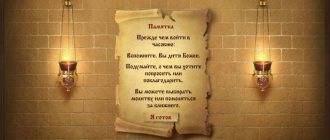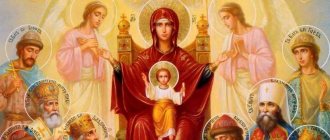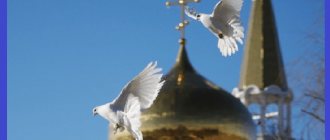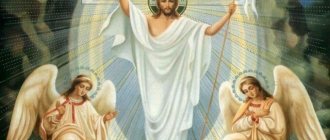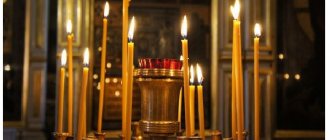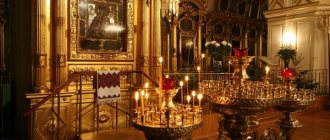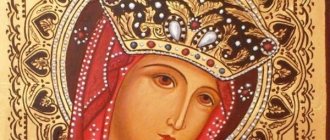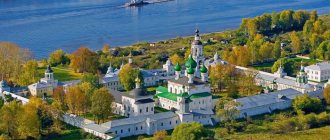What is "Deesis"?
Estimated reading time: 1 min.
Dmitry Trofimov, head of creative workshops “Tsargrad”
The Greek word “deisis” (in the Russian version of pronunciation - “deesis”) most often refers to the central row of the iconostasis. The main place in it is occupied by the icon of Christ on the throne. On either side of it are life-size images of saints. All the saints are turned towards Christ, their hands are folded in prayerful gestures. They turn to the Creator with a prayer for the salvation of the world on the Day of Judgment. Often the texts of their prayers are written on scrolls that they hold in their hands.
The same term refers to other images. They can be found in wall paintings in different parts of the temple outside and inside: in the altar, in the niche of the main apse, on the pre-altar arch, on the inner wall of the church, above the entrance to the temple.
For example, in the painting of the altar of the Transfiguration Cathedral of the Mirozh Monastery, the deesis depicts the Savior on the throne and the upcoming Virgin Mary with John the Baptist. And on the fresco of the Martyrievskaya porch in Novgorod Sofia, the composition of the Deesis consisted of seven half-length images. In addition to Christ, the Virgin Mary and the Forerunner, it included two more archangels - Michael and Gabriel, the apostles Peter and Paul.
Why then are all these images in icons and monumental paintings called Deesis? The answer lies in the Greek word “deisis” (δεησις), which means “prayer” or “petition.” All these are images of prayer that saints and heavenly powers offer to the Lord and Heavenly Judge for the human race. And the first among the prayer intercessors are the Mother of God and the prophet John the Baptist.
Source
Other icons of Christ the Savior
There are other icons of Christ in Orthodox iconography. Thus, on the icon “Savior of the Good Silence” He appears as an angel in the form of a young man in white robes and with wings, that is, even before His incarnation in human form.
On the icon “Savior the Great Bishop” Jesus appears in magnificent priestly robes, with a crown on his head and the Gospel in his hands, blessing humanity.
The Good Shepherd icon embodies the image of Jesus the Shepherd, that is, a shepherd tending His flock (people), often with a sheep on his shoulders, symbolizing lost souls.
The icon “Christ in the Tomb” and the icon “Savior in the Crown of Thorns” represent the most tragic moments of the Savior’s earthly life – the Passion of Christ. They are called to remind people what torment the Savior had to endure for them, and how humbly He accepted them.
Orthodox Life
Archpriest Vladimir Dolgikh answers.
If we look closely at the iconostasis of various churches, we will notice some patterns. That is, iconostases are formed not just like that, at the request of the artist or abbot, but according to certain rules. When there are several rows in the iconostasis, then most likely there will be a Deesis row (third from the bottom). Also, the Deesis rank (instead of the usual seraphim) is sometimes depicted on the dolls of the Moscow Patriarchs.
The term “Deesis” will initially be a little jarring for a Russian-speaking person, especially a believer. We are accustomed to the fact that the prefix de- means a negative action, and we immediately associate the name Jesus with our Savior. As a result, we get something like some kind of anti-Christian concept. What is this? In fact, nothing more than a play on words, unrelated to the true state of affairs. “Deesis” is a Greek word (in the original it sounds like δέησις (“Deesis”)) and means petition or supplication. Most often, this term is used in relation to iconographic images, where the Mother of God, John the Baptist, as well as selected saints whom the icon painter wanted to depict appear before Christ in a prayerful gesture (position).
How does the icon of Jesus Christ the Savior help?
The image of Jesus Christ is central in any temple or home iconostasis.
Any icon of Jesus Christ the Savior has enormous power if prayer in front of it is offered from a pure heart, with sincere faith.
This, in essence, is the meaning of each icon: it is not the icon that answers our prayers, but the saint depicted on it, who intercedes before the Lord for our needs.
Therefore, it does not really matter whether these are the faces of Jesus Christ on the icons of the last century, which today are antiques and are highly valued, or small icons purchased in a church shop - it is not the icon itself that has power, but the one to whom it is dedicated. It is known how popular icons in prayer are among believers and how helpful they are, that is, icons that seem to have absorbed the earnest prayers raised before them by many people. You can pray to the Icon of the Savior for any of your needs, but do not forget to read the main prayer daily - “Our Father”. Prayer helps to strengthen one’s faith, overcome despair, make the right decision and follow the righteous path.
The icons of the twelve, that is, the main Orthodox holidays, depict various episodes of the earthly life of the Savior, from the Nativity to the Crucifixion, as well as those associated with the Mother of God and the Holy Trinity, therefore the celebration of each icon coincides with the corresponding twelve feast.
Story
The name “Deesis” (“Deisis”) appeared in Byzantium and was originally applied to votive icons. What is a votive icon? This is an icon that was painted by order of a person who made a vow, or in gratitude for a fulfilled request. Based on this definition, it is easy to guess that in this case, next to Christ, not only the Mother of God and John the Baptist were depicted, but more often those saints to whom the customer addressed and is addressing in his prayers.
In the 11th century we see that the Deisis is already perceived as a certain, separate type of icon. The Byzantine historian Michael Attaliat mentions this in his Diataxis, a special document regulating the external (ritual) aspect of the celebration of the Liturgy. He writes that the Deisis icon was installed in the center of the templon, or tyabla - a special crossbar made of wood or stone, to which the iconostasis images are attached.
Deisis in the most common, so-called abbreviated iconographic scheme, representing, as already mentioned, the image of Christ with the upcoming Mother of God and the Forerunner, became most widespread in the post-iconoclast period. The multi-figure icon of Deisis appears in the 10th century: the Limburg image is known, which also depicts the Archangels Michael and Gabriel. In the St. Sophia Cathedral in Novgorod, the 7-figure Deisis dates back to the 12th century, where images of the apostles Peter and Paul were added. Around the same period, the so-called Apostolic Deisis appears with the twelve disciples standing before Christ. Initially, it was depicted on the walls, as, for example, in the Vlkmts monastery. Catherine on Sinai, and then gradually, especially in the Russian tradition, stood out as a separate row of the iconostasis.
Ideological content
In many ways, the formation of the ideological content of the image of Deisis was influenced by the liturgical tradition of the Church. The central figure is always the Savior as King, to whom the prayer of thanksgiving of the Eucharist is offered. That is why a cross is never depicted in this image. The atoning sacrifice has already been completed, the Last Judgment awaits us ahead - and the entire Church, both Heavenly and earthly, is turning to Christ in a request for a good answer.
Also, the basis of the image of Deisis was the prayer read during the litia at Vespers, because, as we remember, in it we resort to the intercession of the Mother of God, and John the Baptist, and the Heavenly Powers, and the Apostles, and many other saints who shone in various ranks
Deisis (Deesis) is one of many rich iconographic images that capture the depth of meaning. This is a theology of colors, necessary not only for attentive and collected prayer, but also for reflection on eternal themes.
Source
Why is the series called that?
The word underlying the name "Deesis" is of Greek origin. Its exact pronunciation is a subject of debate among linguists and philologists. Many of them are inclined to believe that “Deesis” is a simplified pronunciation, that is, a Russified form of the word. It is more correctly pronounced “deisis”. However, the clergy have no position on the correct pronunciation; the clergy allows both options.
The word “rank” is originally Slavic. It has several meanings, but in worship this word means a strictly defined order of something. This can be either the sequence of prayers during the service, or its charter, or some other order.
Deesis
Deesis
(Greek δεησις -
petition
,
prayer
;
deisis
) - an icon or group of icons with an image of Christ in the center (most often in the iconography of the Pantocrator), and to the right and left of him, respectively, the Mother of God and John the Baptist, represented in the traditional gesture of prayerful intercession (
three-figure deesis
).
May include similar images of apostles, holy fathers, martyrs and others ( multi-figure deesis
). The main dogmatic meaning of the Deesis composition is mediatory prayer, intercession for the human race in the face of the formidable Heavenly King and Judge. The formation of this iconography was influenced by liturgy. In the post-iconoclastic era, the Deesis icon was placed on the architrave of the low altar barrier of a Byzantine church, and then, on Russian soil, it turned into the Deesis tier of a high iconostasis.
One of the earliest surviving examples of the Deesis is a fresco in the Roman church of Santa Maria Antiqua in Rome (7th century) - it depicts Jesus Christ in full growth, and John the Baptist has a pointing gesture rather than a prayer.
An independent iconographic composition, built according to the type of deesis, is called “ The Queen appears at Your right hand.”
"or more briefly, "
Present the Queen
."
In it, Christ sits on the throne in the image of the King of kings
, to the right (right) of Him (to the left in relation to the viewer) is the Virgin Mary standing tall in royal robes, on the other side is John the Baptist.
From the XII-XIV centuries. in the Balkans, the image of Christ - the King of kings in the composition of the Presta Queen is combined with another iconographic type - the Great Bishop
.
«Angelic Deesis
" is the name of an iconographic composition that includes Christ Emmanuel and two archangels - Michael and Gabriel. There is a rather controversial opinion that this composition is a symbolic image of the Trinity.
The home iconostasis - a set of family prayer icons occupying the red corner of the room - repeats the principles of the temple iconostasis, however, the image of John the Baptist is often replaced by an icon of Nicholas of Myra (Nicholas the Wonderworker), the most revered saint in Russia.
Basic rules for depicting Jesus Christ on icons
In Orthodox icon painting, certain canonical rules for the depiction of Christ have developed; All Orthodox icons of the Lord Jesus Christ can be classified into certain types:
According to legend, the king of Edessa, who fell ill with leprosy, sent a messenger to Jesus with a request to come and heal him, and if Jesus did not agree, then at least receive his painted face. Jesus was constantly surrounded by a crowd, and the artist had no opportunity to draw him.
Seeing this, the Savior, having washed his face, wiped it with an ubrus (handkerchief), and His face appeared on the cloth. This image miraculously healed the king of Edessa and subsequently became the basis for a whole iconographic trend in the image of the Savior in icons, called the “Savior Not Made by Hands,” when the icon depicts only the head of Jesus against the background of a plate.
The most common type of icon of Christ is the Savior Pantocrator (Pantocrator), on which He holds the Gospel in his left hand and performs a blessing with his right.
The main iconographic variants of the image of the Savior Almighty include his image from the waist up or in full height, sitting on a throne (such as the icon of the Savior by Andrei Rublev “The Savior is in Power”).
Emmanuel translated from Hebrew means “God with us.” This name is assigned to all images on icons of Jesus, where He appears as a youth. Most often, the image of Emmanuel is present on icons of the Mother of God.
The Deesis represents icons of Jesus Christ with angels, saints, the Mother of God, etc. The Savior Himself is always in the center, most often He appears in the form of a Pantocrator sitting on a throne, with the Mother of God and John the Baptist on the sides. Russian icon painting has developed its own type of Deesis, called the Angelic: this is an icon of Jesus Emmanuel with the archangels Michael and Gabriel standing nearby.
Links
Useful
See what “Deesis” is in other dictionaries:
DEESIS - with the saints on the beaches. Icon. XI century (mon ry vmts. Catherine on Sinai) Deesis with the saints on the beaches. Icon. XI century (mon ry vmts. Catherine on Sinai) Deesis [Greek. δέησις prayer], an image in which various saints stand before Christ for the race... ... Orthodox Encyclopedia
DEESIS - (Greek, from deesis request, prayer). An icon depicting Jesus in the middle. Christ, and on the sides are the Virgin Mary and John the Baptist. Dictionary of foreign words included in the Russian language. Chudinov A.N., 1910. DEESIS Greek. An icon depicting... ... Dictionary of foreign words of the Russian language
deesis - icon, composition, deisis Dictionary of Russian synonyms. deesis noun, number of synonyms: 3 • deisis (1) • icon ... Dictionary of synonyms
DEESIS - (from the Greek deesis prayer) in medieval, mainly Eastern European art, a composition including images of Christ (in the middle) and the Mother of God and John the Baptist facing him in prayerful poses ... Big Encyclopedic Dictionary
DEESIS - husband. three icons: the Savior, the Mother of God and the Forerunner, placed, according to custom, together. Dahl's Explanatory Dictionary. IN AND. Dahl. 1863 1866 ... Dahl's Explanatory Dictionary
Deesis - Nowadays ancient icons are called dami, mainly a three-faced icon of this composition: the Savior in the middle, and on the sides the Mother of God and John the Baptist. This icon was extremely common among us in the 17th century; it fit... Encyclopedic Dictionary F.A. Brockhaus and I.A. Efron
deesis - (from the Greek déēsis prayer), in medieval, mainly Eastern European art, a composition including images of Christ (in the middle) and the Mother of God and John the Baptist facing him in prayerful poses. * * * DEESIS DEESIS (from the Greek ... Encyclopedic Dictionary
Deesis - deisis (from the Greek déesis prayer), the Old Russian name of the composition depicting Christ in the middle and the Mother of God and John the Baptist facing him in prayerful poses. In icon painting (See Iconography) it was initially performed on one board.... ... Great Soviet Encyclopedia
Deesis - m. 1. Iconographic composition with the image of Christ in the center and the Mother of God and John the Baptist facing him in prayerful poses on the sides. 2. An icon with this image. Ephraim's explanatory dictionary. T. F. Efremova. 2000 ... Modern explanatory dictionary of the Russian language by Efremova
Source
DEESIS
D.'s iconography is varied. The compositions differ in the composition of the saints, the number of figures, the iconography of the central image of Christ, as well as the Mother of God and St. John the Baptist, gestures of characters, their attributes, texts in codices and on scrolls, nuances of turns of figures, sizes and types of images (full-length, half-length, main). One of the earliest examples of D. is the fresco c. Santa Maria Antiqua in Rome (VII century): Christ is depicted full-length, St. John the Baptist is presented not with a prayerful, but with a pointing gesture.
Three-figure D.
(trimorph, Greek: τρίμορφος, τριμόρφιον, τριπρόσωπος παράστασις).
From the 11th century D.-trimorph becomes where the Mother of God and St. John the Baptist is presented as an intercessor for the human race before Christ the Judge (miniature from the 11th century Gospel - Рaris. gr. 74; 12th century icon from the Monastery of the Great Martyr Catherine on Sinai, painting of the Church of Panagia Chalkeon in Thessalonica, 1028; mosaics of the Church of Santa Maria Assunta in Torcello, about 1130).
Multi-figure D.
In a 5-figure D. on an embroidered veil, the 2nd floor. XIV century (NGOMZ) on the sides of the Savior on the throne the upcoming ones are depicted on a smaller scale than the central figure. Archangels in lores hold labarums and mirrors. Deesis composition with the Image of the Savior Not Made by Hands in the center, the Mother of God, St. John the Baptist, Archangels Michael and Gabriel and 4 Rus. the saints are presented in the embroidered air of the book. Maria Tverskaya (1389, State Historical Museum). On the Pskov icon. XV century (the central part of the triptych with D. and selected saints) the archangels are in the 2nd plan, behind the throne of the Savior, their faces are inclined towards the Mother of God and St. John the Baptist.
Source
Iconography
The Deesis folding frame was cast from copper by an unknown artist in the 19th century. In the central part, Christ is depicted in the image of Pantocrator - on the throne and in royal robes. This is how he was portrayed when they wanted to emphasize that he rules the whole world. With his right hand the Savior blesses, and in his left he holds the open Gospel.
On the left side of the fold there is an image of the Mother of God, who unrolled a scroll in front of Jesus, on the right - John the Baptist. With his left hand, the Baptist presses the infant Christ to his stomach in a round dish, a paten, and an expanded list with text.
Source
Deesis rank
Deesis
(Greek δεησις -
petition
,
prayer
;
deisis
) - an icon or group of icons with an image of Christ in the center (most often in the iconography of the Pantocrator), and to the right and left of him, respectively, the Mother of God and John the Baptist, represented in the traditional gesture of prayerful intercession. May include similar images of apostles, holy fathers, martyrs and others. The main dogmatic meaning of the Deesis composition is mediatory prayer, intercession for the human race in the face of the formidable Heavenly King and Judge. In the post-iconoclastic era, the Deesis icon was placed on the architrave of the low altar barrier of a Byzantine church, and then, on Russian soil, it turned into the Deesis tier of a high iconostasis.
An independent iconographic composition, built according to the type of deesis, is called “ The Queen appears at Your right hand.”
"or more briefly, "
Present the Queen
."
In it, Christ sits on the throne in the image of the King of kings
, to the right (right) of Him (to the left in relation to the viewer) is the Virgin Mary standing tall in royal robes, on the other side is John the Baptist.
From the XII-XIV centuries. in the Balkans, the image of Christ - the King of kings in the composition of the Presta Queen is combined with another iconographic type - the Great Bishop
.
The home iconostasis - a set of family prayer icons occupying the red corner of the room - repeats the principles of the temple iconostasis, however, the image of John the Baptist is often replaced by an icon of Nicholas of Myra (Nicholas the Wonderworker), the most revered saint in Russia.
«Angelic Deesis
" is the name of an iconographic composition that includes Christ Emmanuel and two archangels - Michael and Gabriel. There is a rather controversial opinion that this composition is a symbolic image of the Trinity.
Etymology and composition
Deesis is an icon with Jesus Christ at the center. From Greek the word is translated as bowing, petition. John the Baptist and the Mother of God are always present at the Deesis; they turn to the Savior in prayer. Other saints could also be depicted on the Deesis - apostles, great martyrs, prophets or archangels.
The word “Deesis” was first mentioned in the text of the Ipatiev Chronicle of 1288. In Rus', it had three meanings: this was the name of the icons that depict Christ with the Mother of God and John the Baptist, the row in which similar icons stood, as well as all the icons, except for the third row of the iconostasis - the local one.
The Deesis has two types of composition. The first - in which only the heads of the Savior, the Mother of God and the Forerunner were depicted or their figures up to the chest. Usually they decorated the entrance to the temple or the space above the altar. The second type includes those where the Mother of God and John the Baptist are presented in full growth and pray before Christ. Sometimes this scene was combined on the icon with the scene of the Last Judgment; John the Baptist and the Mother of God symbolized prayer for all believers. Such images are based on the texts of ancient liturgies.

